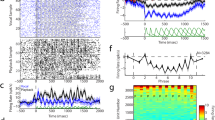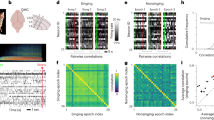Abstract
In this paper, we present a vocal production protocol for studying the neurophysiological action of the corollary discharge, a mechanism that allows animals to ignore sensations resulting from their own actions, and tag them as 'self'. Electroencephalograms are recorded while subjects say 'ah' about 100 times with minimal throat, jaw and tongue movements (Talk condition). This sequence of sounds is recorded and played back during the Listen condition. Event-related potentials are synchronized to the onset of speech sounds during the Talk and Listen conditions. Neural responses from the auditory cortex to the spoken sound as it is being spoken during the Talk condition are compared with neural responses to the same sounds when played back during the Listen condition. The successful action of the corollary discharge is seen when the response of the auditory cortex is suppressed during the Talk compared with the Listen condition. The protocol takes about 5 min to complete.
This is a preview of subscription content, access via your institution
Access options
Subscribe to this journal
Receive 12 print issues and online access
$259.00 per year
only $21.58 per issue
Buy this article
- Purchase on Springer Link
- Instant access to full article PDF
Prices may be subject to local taxes which are calculated during checkout






Similar content being viewed by others
References
Crapse, T.B. & Sommer, M.A. Corollary discharge across the animal kingdom. Nat. Rev. Neurosci. 9, 587–600 (2008).
Helmholtz, H. Movements of the eyes, Chapter 27. In Helmholtz's Treatise on Physiological Optics Vol. 3 (ed. Southall, J.P.C.) Translated from the Third German edn. 37–154 (Optical Society of America, Rochester, NY, 1925).
Von Holst, E. & Mittelstaedt, H. Das Reafferenzprinzip. Naturwissenschaften 37, 464–476 (1950).
Sperry, R.W. Neural basis of the spontaneous optokinetic response produced by visual inversion. J. Comp. Physiol. Psychol. 43, 482–489 (1950).
Poulet, J.F. & Hedwig, B. The cellular basis of a corollary discharge. Science 311, 518–522 (2006).
Sommer, M.A. & Wurtz, R.H. Influence of the thalamus on spatial visual processing in frontal cortex. Nature 444, 374–377 (2006).
Creutzfeldt, O., Ojeman, G. & Lettich, E. Neuronal activity in the human lateral temporal lobe. II Responses to the subject's own voice. Exp. Brain Res. 77, 476–489 (1989).
Eliades, S.J. & Wang, X. Dynamics of auditory-vocal interaction in monkey auditory cortex. Cereb. Cortex 15, 1510–1523 (2005).
Eliades, S.J. & Wang, X. Sensory-motor interaction in the primate auditory cortex during self-initiated vocalizations. J. Neurophysiol. 89, 2194–2207 (2003).
Eliades, S.J. & Wang, X. Neural substrates of vocalization feedback monitoring in primate auditory cortex. Nature 453, 1102–1106 (2008).
Behroozmand, R., Karvelis, L., Liu, H. & Larson, C.R. Vocalization-induced enhancement of the auditory cortex responsiveness during voice F0 feedback perturbation. Clin. Neurophysiol. 120, 1303–1312 (2009).
Snowdon, C.T. & Elowson, A.M. Pygmy marmosets modify call structure when paired. Ethology 105, 893–908 (1999).
Houde, J.F., Nagarajan, S.S., Sekihara, K. & Merzenich, M.M. Modulation of the auditory cortex during speech: an MEG study. J. Cogn. Neurosci. 14, 1125–1138 (2002).
Curio, G., Neuloh, G., Numminen, J., Jousmaki, V. & Hari, R. Speaking modifies voice-evoked activity in the human auditory cortex. Hum. Brain Mapp. 9, 183–191 (2000).
Ford, J.M., Gray, M., Faustman, W.O., Roach, B.J. & Mathalon, D.H. Dissecting corollary discharge dysfunction in schizophrenia. Psychophysiology 44, 522–529 (2007).
Ford, J.M., Roach, B.J., Faustman, W.O. & Mathalon, D.H. Synch before you speak: auditory hallucinations in schizophrenia. Am. J. Psychiatry. 164, 458–466 (2007).
Heinks-Maldonado, T.H., Mathalon, D.H., Gray, M. & Ford, J.M. Fine-tuning of auditory cortex during speech production. Psychophysiology 42, 180–190 (2005).
Heinks-Maldonado, T.H., Mathalon, D.H., Houde, J.F., Gray, M., Faustman, W.O. & Ford, J.M. Relationship of imprecise corollary discharge in schizophrenia to auditory hallucinations. Arch. Gen. Psychiatry. 64, 286–296 (2007).
Ford, J.M., Mathalon, D.H., Heinks, T., Kalba, S. & Roth, W.T. Neurophysiological evidence of corollary discharge dysfunction in schizophrenia. Am. J. Psychiatry 158, 2069–2071 (2001).
Feinberg, I. Efference copy and corollary discharge: implications for thinking and its disorders. Schizophr. Bull. 4, 636–640 (1978).
Frith, C.D. The positive and negative symptoms of schizophrenia reflect impairments in the perception and initiation of action. Psychol. Med. 17, 631–648 (1987).
Lindner, A., Their, P., Kircher, T.T., Haarmeier, T. & Leube, D.T. Disorders of agency in schizophrenia correlate with an inability to compensate for the sensory consequences of actions. Curr. Biol. 15, 1119–1124 (2005).
Stirling, J.D., Hellewell, J.S. & Quraishi, N. Self-monitoring dysfunction and the schizophrenic symptoms of alien control. Psychol. Med. 28, 675–683 (1998).
Brebion, G., Amador, X., David, A.S., Malaspina, D., Sharif, Z. & Gorman, J.M. Positive symptomatology and source-monitoring failure in schizophrenia–an analysis of symptom-specific effects. Psychiatry Res. 95, 119–131 (2000).
Shergill, S.S., Samson, G., Bays, P.M., Frith, C.D. & Wolpert, D.M. Evidence for sensory prediction deficits in schizophrenia. Am. J. Psychiatry 162, 2384–2386 (2005).
Turken, A.U., Vuilleumier, P., Mathalon, D.H., Swick, D. & Ford, J.M. Are impairments of action monitoring and executive control dissociable dysfunctions in patients with schizophrenia? Am. J. Psychiatry 160, 1881–1883 (2003).
Frith, C.D., Blakemore, S.J. & Wolpert, D.M. Explaining the symptoms of schizophrenia: abnormalities in the awareness of action. Brain Res. Brain Res. Rev. 31, 357–363 (2000).
Ford, J.M., Mathalon, D.H., Kalba, S., Whitfield, S., Faustman, W.O. & Roth, W.T. Cortical responsiveness during inner speech in schizophrenia: an event-related brain potential study. Am. J. Psychiatry 158, 1914–1916 (2001).
Ford, J.M., Mathalon, D.H., Kalba, S., Whitfield, S., Faustman, W.O. & Roth, W.T. Cortical responsiveness during talking and listening in schizophrenia: an event-related brain potential study. Biol. Psychiatry 50, 540–549 (2001).
Ford, J.M., Roach, B.J., Faustman, W.O. & Mathalon, D.H. Out-of-synch and out-of-sorts: dysfunction of motor-sensory communication in schizophrenia. Biol. Psychiatry 63, 736–743 (2008).
Timmons, B.A. & Boudreau, J.P. Auditory feedback as a major factor in stuttering. J. Speech Hear. Disord. 37, 476–484 (1972).
Heinks-Maldonado, T.H., Nagarajan, S.S. & Houde, J.F. Magnetoencephalographic evidence for a precise forward model in speech production. Neuroreport 17, 1375–1379 (2006).
Ventura, M.I., Nagarajan, S.S. & Houde, J.F. Speech target modulates speaking induced suppression in auditory cortex. BMC Neurosci. 10, 58 (2009).
Blakemore, S.J., Wolpert, D.M. & Frith, C.D. Central cancellation of self-produced tickle sensation. Nat. Neurosci. 1, 635–640 (1998).
Blakemore, S.J., Wolpert, D. & Frith, C. Why can't you tickle yourself? Neuroreport 11, R11–R16 (2000).
Shergill, S.S., Bays, P.M., Frith, C.D. & Wolpert, D.M. Two eyes for an eye: the neuroscience of force escalation. Science 301, 187 (2003).
Ford, J.M. & Mathalon, D.H. Auditory hallucinations in schizophrenia. In Handbook of Neuropsychology of Mental Illness (eds. Wood, S., Allen, N., Pantelis, C.) Ch.15, 221–232 (Cambridge University Press, Melbourne, 2009).
Lane, H. & Tranel, B. The Lombard sing and the role of hearing in speech. J. Speech Hear. Res. 14, 677–709 (1971).
Pantev, C. et al. Specific tonotopic organizations of different areas of the human auditory cortex revealed by simultaneous magnetic and electric recordings. Electroencephalogr. Clin. Neurophysiol. 94, 26–40 (1995).
Oostenveld, R. & Praamstra, P. The five percent electrode system for high-resolution EEG and ERP measurements. Clin. Neurophysiol. 112, 713–719 (2001).
Schafer, E.W. & Marcus, M.M. Self-stimulation alters human sensory brain responses. Science 181, 175–177 (1973).
Martikainen, M.H., Kaneko, K. & Hari, R. Suppressed responses to self-triggered sounds in the human auditory cortex. Cereb. Cortex. 15, 299–302 (2005).
Aliu, S.O., Houde, J.F. & Nagarajan, S.S. Motor-induced suppression of the auditory cortex. J. Cogn. Neurosci. 21, 791–802 (2009).
Bass, P., Jacobsen, T. & Schroger, E. Suppression of the auditory N1 event-related potential component with unpredictable self-initiated tones: evidence for internal forward models with dynamic stimulation. Int. J. Psychophysiol. 70, 137–143 (2008).
Acknowledgements
We thank S. Guillory for programming the Matlab task. This work was supported by the VA Research Service and grants from the VA (Merit Review), the National Institute of Mental Health (MH40052, MH 58262, MH067967) and the National Alliance for Research in Schizophrenia and Affective Disorders (NARSAD).
Author information
Authors and Affiliations
Contributions
J.M.F. wrote the nontechnical parts of the protocol and edited the technical aspects of the paper; B.J.R. contributed to paradigm programming and to the technical aspects of the paper; D.H.M. contributed to paradigm development and to the nontechnical aspects of the paper.
Corresponding author
Ethics declarations
Competing interests
The authors declare no competing financial interests.
Supplementary information
Supplementary File 1: Matlab task zip
This zip file contains all the functions and scripts necessary to run the talk and listen tasks on a computer where the matlab psychtoolbox is installed. The main scripts to run are referred to in the procedures for those conducting the experiment in the matlab environment. (ZIP 21 kb)
Supplementary File 2: Presentation task zip
This zip file contains all the files and functions necessary to run the talk and listen tasks on a computer where the Presentation software is installed. The main scenarios to run are referred to in the procedures for those conducting the experiment in the Presentation environment. (ZIP 12857 kb)
Supplementary Video 1: Windows XP sound setup
This quicktime movie describes Windows XP sound control panel settings required to properly run the talk and listen ERP protocol. (MOV 5131 kb)
Supplementary Video 2: : Talk instructions
This quicktime movie provides participants with instructions for the talk task. These instructions should be presented to the subject during step 8 of the protocol procedure. (MOV 1134 kb)
Supplementary Video 3: Listen instructions
This quicktime movie provides participants with instructions for the listen task. These instructions should be presented to the subject during step 26 of the protocol procedure. (MOV 248 kb)
Rights and permissions
About this article
Cite this article
Ford, J., Roach, B. & Mathalon, D. Assessing corollary discharge in humans using noninvasive neurophysiological methods. Nat Protoc 5, 1160–1168 (2010). https://doi.org/10.1038/nprot.2010.67
Published:
Issue Date:
DOI: https://doi.org/10.1038/nprot.2010.67
This article is cited by
-
Voice-selective prediction alterations in nonclinical voice hearers
Scientific Reports (2018)
-
Echoes on the motor network: how internal motor control structures afford sensory experience
Brain Structure and Function (2017)
Comments
By submitting a comment you agree to abide by our Terms and Community Guidelines. If you find something abusive or that does not comply with our terms or guidelines please flag it as inappropriate.



